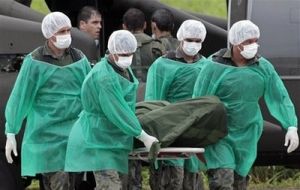MercoPress. South Atlantic News Agency
US investigators looking into new Airbus 330 incidents with Pitot tubes
 French authorities have identified the bodies of a pilot and a cabin crew member
French authorities have identified the bodies of a pilot and a cabin crew member United States aviation accident investigators have launched probes into two recent incidents aboard Airbus A330 jets that appear to have similarities to the failures reported on the Air France jet Flight 447 that disappeared over the Atlantic Ocean on June 1.
The National Transportation Safety Board (NTSB) said Thursday it is looking into incidents on Northwest Airlines and Brazil's TAM Airlines in which pilots on the long-range, wide body jet received apparently erroneous airspeed and altitude data.
The investigation into the disappearance of Air France Flight 447, an A330 with 228 people aboard, has focused on the apparent failures of air pressure sensors that measure a jet's speed. The sensors are known as Pitot tubes. Data messages sent from the jet to an Air France maintenance computer indicated that the sensors failed minutes before the plane went down.
The failure of external air pressure sensors occur relatively frequently on all types of aircraft without serious consequences, according to US aviation data bases. However, the failures can lead to critical problems if pilots do not respond properly and such failures have been linked to at least four fatal crashes around the world.
The NTSB, which is assisting French investigators in the Air France investigation, said it is looking into a Northwest flight from Hong Kong to Tokyo on Tuesday during which apparent similar failures occurred. The NTSB is collecting flight recorders, maintenance data, weather information and statements from the crew, the agency said. The flight landed safely in Tokyo.
In another incident on May 21, TAM Flight 8091 from Miami to São Paulo lost speed and altitude information in the cockpit, the NTSB said. The crew noticed a rapid drop in outside temperature while cruising, followed by several abrupt failures. The autopilot and throttle controls disconnected and the crew lost speed and altitude information, the NTSB said.
The crew was able to fly the plane using backup instruments. Speed and altitude information returned after about five minutes and the plane landed safely in São Paulo.
The incidents could shed light on the Air France investigation. Last year, Airbus advised airlines to replace Pitot tubes on A330s because they could provide erroneous readings in bad weather, but many airlines have not completed the switch.
Meantime it was reported that French authorities identified the chief pilot and a member of the cabin crew of the Air France Flight 447. The two bodies were found as authorities continued their search for the black boxes of the Air France flight.
“Among the victims found in the sea search, two members of the Air France crew have been identified: the flight captain and a steward,” said Air France. It is not clear whether the two are among the 11 victims already identified.
Air France has not identified the pilot by name, but a pilot's union identified the captain as Marc Dubois. The CEO of Air France, Pierre-Henri Gourgeon, extended his condolences to the families on behalf of the airline.
So far, the international police agency Interpol said 11 of the 51 bodies retrieved have been identified. It says they are eight Brazilians, one with joint Brazilian-German citizenship, one Brazilian-Swiss and a British national.
The Airbus A330 aircraft was carrying 216 passengers and a crew of 12 when it plunged into the Atlantic Ocean some 1,200 kilometers off the Brazilian coastline while on a flight from Rio de Janeiro to Paris.
The French Office of Accident Investigation and Analysis (BEA), which is leading an investigation into the crash, said it would issue a preliminary report on its findings before the end of the month.




Top Comments
Disclaimer & comment rulesCommenting for this story is now closed.
If you have a Facebook account, become a fan and comment on our Facebook Page!